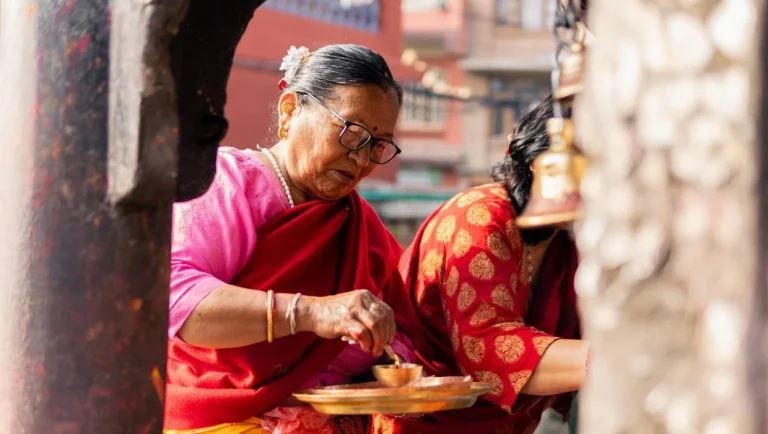When most people think of Nepal, they picture high mountains and world-famous trekking trails. But a new way of travel is changing that view. The Kathmandu homestay experience invites travelers to connect with local families and explore hidden cultural gems in the valley.
On a recent visit, our journey began in Kirtipur, a historic Newar town just outside Kathmandu. There, we met our hosts, Ganga Devi Maharjan and her husband, Dilip. Their home, simple and four stories tall, became our base. Though climbing to the rooftop was a workout, the reward was worth it—stunning views of the valley and, on clear days, even Mount Everest.
We were warmly welcomed by the Newar community with a traditional Hindu Tika ceremony. Red marks made of rice, yogurt, and vermillion were gently placed on our foreheads—a blessing for good fortune. It set the tone for a visit full of meaning, learning, and connection.
That night, Ganga taught us to cook Nepal’s most beloved dish—momos. Sitting at a long table with flour-dusted hands, we folded and pinched dough to make dumplings. Ganga, with endless patience, guided us step by step. The momo-making class is one of the most popular parts of the program. Since 2023, over 2,000 visitors have joined these workshops, creating more than 20,000 momos and providing steady income for local women.
Kabita Maharjan, a homestay host and workshop leader, shared how the program changed her life. “I feel proud that I now have a say in family decisions,” she said. Her earnings have allowed her to buy a phone, send pocket money to her son abroad, and even help her husband financially. “Now he asks me for money,” she added with a smile.
The Kathmandu homestay experience is part of the Hidden Gems of the Kathmandu Valley circuit. This eight-day journey, organized by Community Homestay Network, goes beyond the typical tourist spots. Instead, it focuses on local traditions, heritage sites, and lesser-known towns and villages. Tour leaders Monica K.C. and Poonam Gupta Shrestha guide small groups through this immersive cultural route.
“This trip highlights indigenous groups and supports places that don’t often see tourists,” Monica explained during the drive to our first homestay. And it works. About 80% of the money earned through the program goes directly to local families and their communities.
In Kirtipur, we explored sacred sites like the 16th-century Bagh Bhairab Temple, dedicated to the Hindu god Shiva. The smell of incense and the sound of bells filled the peaceful air. We also visited Chilancho Stupa, a Buddhist site believed to date back to the 3rd century. Surrounded by prayer flags and crowned with a white dome, it stood like a quiet guardian of time.
Another visit took us to the woodcarving village of Bungamati. There, artisans demonstrated the craft of teak carving. After watching them work, I looked at temple carvings with new eyes, realizing the immense skill required.
Back in Kirtipur, Ganga treated us to Dal Bhat, Nepal’s classic lentil and rice meal. Later, we joined her in the bustling local market to shop for ingredients. We also dressed in traditional Newari clothing and took part in a rare Ranjana Lipi writing class.
Held in the historic Kipoo House, the workshop taught us how to write using an ancient script. Once widely used in Buddhist prayers, Ranjana Lipi is now at risk of disappearing. By teaching it to visitors, locals are helping to preserve this part of Nepal’s heritage—and earning income at the same time.
We dipped bamboo pens in ink and copied the elegant strokes, guided by our teacher’s calm voice. As a reward, we enjoyed a special meal called Samaye Baji, shared with community members. It was a delicious reminder of how food and culture are deeply connected.
Throughout our stay, the warmth and generosity of our hosts stood out. They opened their homes, shared their stories, and helped us understand what life in Nepal is really like. We didn’t just visit tourist sites—we became part of a living culture.
The Kathmandu homestay experience is more than a vacation. It’s a way to travel with purpose. It helps local women gain independence. It preserves languages, skills, and traditions. And it offers travelers something no hotel ever could—true connection.
By choosing this kind of travel, we aren’t just making momos or writing mantras. We’re helping build a more equal and sustainable future. And we’re leaving with memories that go far beyond the postcard views.


